|
June 1941 Popular Science
 [Table of Contents] [Table of Contents]
Wax nostalgic about and learn from the history of early
electronics. See articles from
Popular
Science, published 1872-2021. All copyrights hereby acknowledged.
|
June of 1941, when this
"America Listens In" article appeared in Popular Science magazine, was
half a year before the Japanese Imperial Navy launched its surprise attack on
the U.S. Navy at Pearl Harbor. We had been unofficially providing England,
France, and a handful of other western European countries with intelligence data
and even some military hardware and troop training, but had no Congressionally
declared entrance into what would become World War II. Described here are
methods and equipment used to listen in on, translate, and study foreign
broadcasts, mostly from Germany. Use of wax cylinders for recording voice
broadcasts was state of the art at the time, since magnetic tape technology was
still in its infancy. Maybe we should have been putting as much effort into
monitoring Japanese broadcasts; we might have averted the attack. BTW, if you
think the current state of affairs regarding strife engendered between people
groups being the work of media, dig this from the article: "Ill feeling of another kind is the aim of the propaganda of dissension. By recalling
dissatisfactions, grievances and class hatreds within the United States itself,
it seeks to produce internal quarrels. By distorting news items, it calls attention
to the differences of labor and capital, of Jews and Christians, of negroes and
whites. The goal of this type of short-wave propaganda is to produce continual friction
and prevent the nation from becoming an efficient, smooth-running machine." Of
course there are people who say the U.S. knew of the impending action and
allowed it in order to justify joining the battle. The older I get and the more
I observe and learn as previously inaccessible information is more easily
obtained, the more dubious I become of any action / reaction of governments
worldwide.
America Listens In
 Day-by-Day Recordings of Europe's Radio Programs
Reveal the Tricks of Germany's War Propagandists Day-by-Day Recordings of Europe's Radio Programs
Reveal the Tricks of Germany's War Propagandists
By Edwin Teale
In a white frame building on a side street in Princeton, N.J., 8,000,000 words
of radio propaganda have been recorded on wax cylinders, translated, transcribed,
coded, and filed for study. Here, day after day, America listens in. Under the direction
of Harold N. Graves, Jr., and financed by the Rockefeller Foundation, the Princeton
Listening Center has been active since November 27, 1939. It represents America's
first serious attempt to analyze propaganda on the air waves. Similar listening
posts are now being established in various parts of the country by the Federal Communications
Commission and the Defense Communications Board, though their methods of operation
will be different in some respects.
From midafternoon until almost midnight, each day, J. R. Snedeker, the Center's
radio technician, is busy with two short-wave receivers wired directly to electric
recording machines. Earphones on one receiver, and a loudspeaker on the other, enable
him to start recording as each propaganda speech begins.

How German propaganda follows or even forecasts events. Vertical scale represents
references per day.
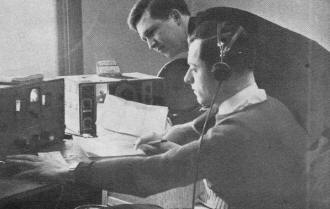
Harold N. Graves, Jr., executive director of the Princeton Listening
Center, with J, R. Snedeker, radio technician (seated), at the two short-wave receiving
sets used in recording the broadcasts.
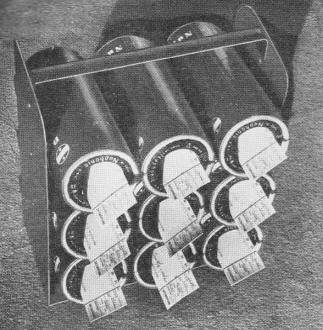
Wax cylinders used during a night's reception are placed in
racks like the one shown above, each identified by a slip filled out by the
operator.

One of these slips.
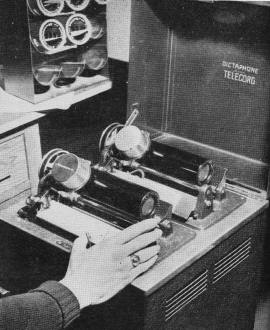
One of two electric recording machines wired to the
receiving sets.
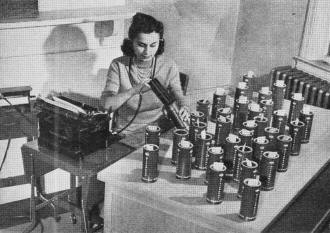
Isotta Masoni, one of the four translators, at work. Foreign-language
speeches are translated and typed out in English
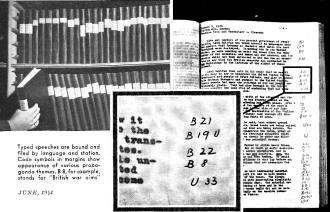
Typed speeches are bound and filed by language and station. Code
symbols in margins show appearance of various propaganda themes. B 8, for example,
stands for "British war aims."
Nearly 9,000 wax cylinders, representing some 100,000 minutes of speaking, have
gone through the Princeton recording machines in the past year and a half. Sometimes
the translators find as many as 40, each with its identifying slip, waiting for
them when they come to work in the morning. Once, Snedeker was 95 records ahead
of the translating staff. But the score was more than evened up last year when sun
spots disrupted short-wave communication for weeks on end.
With earphones clamped to their heads, the four translators type out the speeches
in English. On each typed sheet, in the right-hand margin, a coding expert jots
down symbols to indicate the propaganda theme used by the speakers. Such symbols
enable later research workers to trace the development of any given theme with a
minimum of effort. After coding, the sheets are bound, according to language and
broadcasting station, and filed in a research room upstairs. At present, Graves
is specializing in British propaganda, Philip Jacob in German, and Bruno Foa in
Italian. By means of reports, graphs, and summaries, they are reducing the propaganda
of the belligerent nations to its basic, simple elements.
Germany, in its short-wave bombardment of England and America, makes use of half
a dozen distinctive types of propaganda. The Princeton Listening Center has pigeonholed
them as the propaganda of terrorism, of paralysis, of dissension, of confusion,
of variety, and of division. The different types rise and fall with the shift of
events.
Terrorism propaganda always reaches a peak just before a brutal, all-out attack
from the air. It is the simplest and least subtle of the weapons used in a war of
nerves. The devastation of Warsaw; the destruction of Rotterdam; the terrors that
lie ahead for the women and children of enemy cities, are stressed again and again.
Recently, to increase the depressing effect of British losses at sea, German broadcasting
stations have preceded the announcement of each torpedoed ship with the doleful
tolling of a bell.
Propaganda, as such, rarely changes the natural course of events. But it does
accelerate or slow it down. So, in the early months of the war, Germany concentrated
on the propaganda of paralysis during broadcasts to the United States. In an effort
to slow down the natural drift toward aiding England, it tried to discredit the
press and to make people suspicious of what was printed and what was released by
public officials. It emphasized defeatism and the certainty of Britain's fall. It
praised statements opposing foreign entanglements and lauded America's decision
to keep its ships out of European waters. Before each invasion of a neutral country,
when Americans might be tempted to rush into action, the tempo of this kind of propaganda
was accelerated.
At the same time, an attempt to drive a wedge between Britain and the United
States by the propaganda of division zoomed just before each major move of the German
Army. Berlin broadcasters played up such things as the seizure of American mail
by the British and previous differences between the two nations. They even trotted
out the ancient grudges of the Revolution and the War of 1812 in an effort to alienate
the two countries.
Ill feeling of another kind is the aim of the propaganda of dissension. By recalling
dissatisfactions, grievances and class hatreds within the United States itself,
it seeks to produce internal quarrels. By distorting news items, it calls attention
to the differences of labor and capital, of Jews and Christians, of negroes and
whites. The goal of this type of short-wave propaganda is to produce continual friction
and prevent the nation from becoming an efficient, smooth-running machine.
At the time of the fifth-column scare in this country, still another type of
German propaganda came to the fore. In rapid succession, the Berlin commentators
broadcast varying accounts of the fifth column. First, they maintained it was all
sheer imagination. Then they veered quickly to the idea that it was something concocted
by the British. And, as quickly, they took a new tack. It was, they said, merely
a bogeyman thought up by the Administration to distract attention from its failures.
By pointing in several directions at once, the propaganda of confusion seeks to
bewilder those who might feel impelled to act.
Finally, there is the propaganda of variety. For each aggressive move Germany
has made, the short-wave radio has carried innumerable reasons, explanations and
arguments. By giving a wide variety of arguments, the propagandist tries to suit
everyone. If one of his explanations seems phony, another may carry conviction.
So he uses a verbal shotgun instead of a rifle in his attempts to present events
in the most favorable light.
Close study of these different types of propaganda has enabled the Princeton
listeners, on a number of occasions, to obtain an inkling of coming events. The
propaganda of division, for example, rose to a peak last spring as the German soldiers
overran Belgium, Holland, and France. Later in the summer, it began to subside and
the Princeton experts concluded that the threatened invasion of England had been
postponed. By noting a sudden jump in frightfulness broadcasts, they also were able
to predict, within a few days, the major air offensive against London. Different
types of propaganda, they have found, precede all-out attacks by air and by sea.
The former stresses frightfulness and the terrors of a threatened blitzkrieg from
the sky; the latter features the suffering in countries blockaded by Britain, in
order to justify ruthless attacks on shipping by submarines and aircraft.
Today, as many as 500 propaganda programs a week are aimed at the 20,000,000
receiving sets in the United States capable of picking up short-wave broadcasts.
To cope with this rising tide, the Princeton Listening Center has had to boost its
staff from four to ten. The work of this group represents national preparedness
of a new kind. It is preparedness on the so-called "fourth front" of the war, the
front of propaganda.
1 Propaganda of Terrorism. Its aim is to break down the morale
of the public in enemy countries by threats and "frightfulness" broadcasts.
2 Propaganda of Paralysis. Its goal is to keep America inactive
by dividing sentiment and preventing the people from reaching a united decision.
3 Propaganda of Division. It tries to drive a wedge between
Britain and America by emphasizing frictions and divisions of the post.
4 Propaganda of Dissension. Its aim is to cause ill feeling
in the United States by arraying class against class, creed against creed, race
against race.
5 Propaganda of Confusion. It attempts to prevent prompt action
by public officials by bewildering them with various hints pointing in different
directions.
6 Propaganda of Variety. By giving a large number of arguments
and excuses for Nazi actions, it seeks to convince everyone. Those who reject one
explanation may accept another.
Posted October 11, 2023
|








 Day-by-Day Recordings of Europe's Radio Programs
Reveal the Tricks of Germany's War Propagandists
Day-by-Day Recordings of Europe's Radio Programs
Reveal the Tricks of Germany's War Propagandists 







